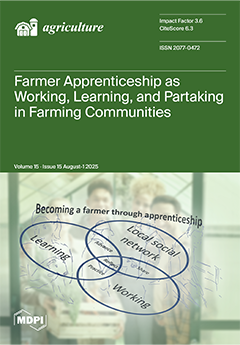Wheat (
Triticum aestivum L.) is a crucial global food crop. The intensive crop farming, monoculture cultivation, and impact of climate change affect the susceptibility of wheat cultivars to biotic stresses, mainly caused by soil fungal pathogens, especially those belonging to the genus
[...] Read more.
Wheat (
Triticum aestivum L.) is a crucial global food crop. The intensive crop farming, monoculture cultivation, and impact of climate change affect the susceptibility of wheat cultivars to biotic stresses, mainly caused by soil fungal pathogens, especially those belonging to the genus
Fusarium. This situation threatens yield and grain quality through root and crown rot. While conventional chemical fungicides face resistance issues and environmental concerns, biological alternatives like seed priming with natural metabolites are gaining attention. Polyamines, including putrescine, spermidine, and spermine, are attractive priming agents influencing plant development and abiotic stress responses. Spermine in particular shows potential for in vitro antifungal activity against
Fusarium. Optimising spermine concentration for seed priming is crucial to maximising protection against
Fusarium infection while ensuring robust plant growth. In this research, we explored the potential of the polyamine spermine as a seed treatment to enhance wheat resilience, aiming to identify a sustainable alternative to synthetic fungicides. Our findings revealed that a six-hour seed soak in spermine solutions ranging from 0.5 to 5 mM did not delay germination or seedling growth. In fact, the 5 mM concentration significantly stimulated root weight and length. In complementary in vitro assays, we evaluated the antifungal activity of spermine (0.5–5 mM) against three
Fusarium species. The results demonstrated complete inhibition of
Fusarium culmorum growth at 5 mM spermine. A less significant effect on
Fusarium graminearum and little to no impact on
Fusarium oxysporum were found. The performed analysis revealed that the spermine had a fungistatic effect against the pathogen, retarding the mycelium growth of
F. culmorum inoculated on the seed surface. A pot experiment with Bulgarian soft wheat cv. Sadovo-1 was carried out to estimate the effect of seed priming with spermine against infection with isolates of pathogenic fungus
F. culmorum on plant growth and disease severity. Our results demonstrated that spermine resulted in a reduced distribution of
F. culmorum and improved plant performance, as evidenced by the higher fresh weight and height of plants pre-treated with spermine. This research describes the efficacy of spermine seed priming as a novel strategy for managing
Fusarium root and crown rot in wheat.
Full article





